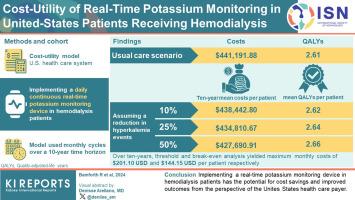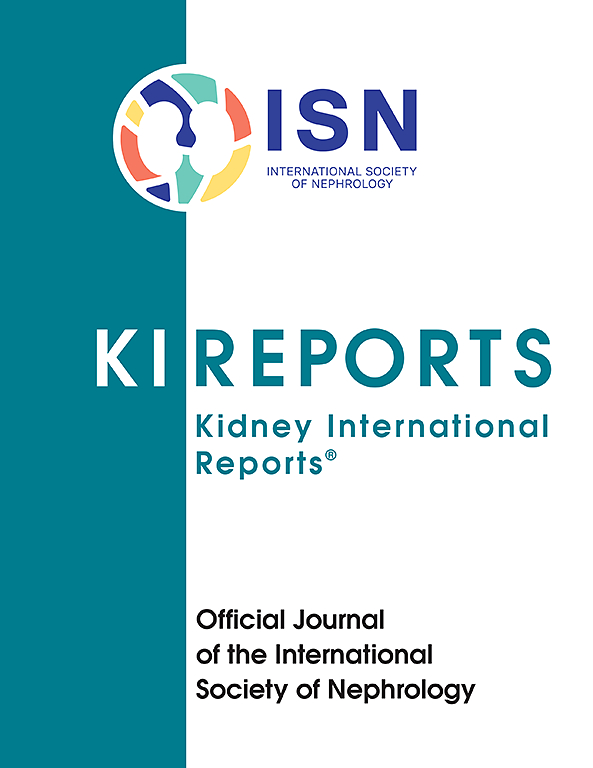Cost-Utility of Real-Time Potassium Monitoring in United States Patients Receiving Hemodialysis
IF 5.7
2区 医学
Q1 UROLOGY & NEPHROLOGY
引用次数: 0
Abstract
Introduction
Patients with kidney failure requiring hemodialysis are at high risk for hyperkalemia between treatments, which is associated with increased cardiovascular morbidity and mortality. Early detection of hyperkalemic events may be useful to prevent adverse outcomes and their associated costs. We performed a cost-utility analysis comparing an intervention where a real-time potassium monitoring device is administered in patients on hemodialysis in comparison to usual care.
Methods
We developed a cost-utility model with microsimulation from the perspective of the United States health care payer. Primary outcomes included the monthly cost-effectiveness threshold cost and break-even cost per patient attributable to the intervention and the incremental cost-effectiveness ratio comparing the intervention to usual care. A 25% reduction in hyperkalemic events was applied as a baseline device effectiveness estimate. Concurrent first and second order microsimulations were performed using 10%, 25%, and 50% effectiveness estimates as sensitivity analyses. Results are presented over a 10-year time horizon in 2022 United States dollars and a willingness-to-pay threshold of $100,000 per quality-adjusted life year (QALY) was considered.
Results
Over 10 years, threshold and break-even analysis yielded maximum monthly costs of $201.10 and $144.15 per patient, respectively. The intervention was associated with reduced mean costs ($6381.21) and increased mean QALYs (0.03) per patient; therefore, was considered dominant. In sensitivity analysis, the intervention was dominant in 99% of simulations performed at all effectiveness rates.
Conclusion
Implementing a real-time potassium monitoring device in patients on hemodialysis has the potential for cost savings and improved outcomes from the perspective of the United States health care payer.

美国血液透析患者实时血钾监测的成本效益
需要进行血液透析的肾衰竭患者在治疗间歇期出现高钾血症的风险很高,这与心血管疾病发病率和死亡率的增加有关。早期发现高钾血症事件可能有助于预防不良后果及其相关费用。我们进行了一项成本效用分析,比较了在血液透析患者中使用实时钾监测装置与常规护理的干预效果。我们从美国医疗支付方的角度开发了一个微观模拟成本效益模型。主要结果包括每位患者每月可归因于干预措施的成本效益阈值成本和盈亏平衡成本,以及干预措施与常规护理的增量成本效益比。高钾血症事件减少 25% 作为基线设备有效性估计值。同时进行了一阶和二阶微观模拟,将 10%、25% 和 50% 的有效性估计值作为敏感性分析。结果以 2022 年美元计算,时间跨度为 10 年,支付意愿阈值为每质量调整生命年 (QALY) 100,000 美元。在 10 年的时间里,阈值分析和盈亏平衡分析得出每位患者每月的最高成本分别为 201.10 美元和 144.15 美元。干预措施降低了每位患者的平均成本(6381.21 美元),增加了平均 QALYs(0.03),因此被认为具有优势。在敏感性分析中,在所有有效率下进行的 99% 模拟中,该干预方法均占主导地位。从美国医疗支付方的角度来看,在血液透析患者中使用实时血钾监测设备具有节约成本和改善疗效的潜力。
本文章由计算机程序翻译,如有差异,请以英文原文为准。
求助全文
约1分钟内获得全文
求助全文
来源期刊

Kidney International Reports
Medicine-Nephrology
CiteScore
7.70
自引率
3.30%
发文量
1578
审稿时长
8 weeks
期刊介绍:
Kidney International Reports, an official journal of the International Society of Nephrology, is a peer-reviewed, open access journal devoted to the publication of leading research and developments related to kidney disease. With the primary aim of contributing to improved care of patients with kidney disease, the journal will publish original clinical and select translational articles and educational content related to the pathogenesis, evaluation and management of acute and chronic kidney disease, end stage renal disease (including transplantation), acid-base, fluid and electrolyte disturbances and hypertension. Of particular interest are submissions related to clinical trials, epidemiology, systematic reviews (including meta-analyses) and outcomes research. The journal will also provide a platform for wider dissemination of national and regional guidelines as well as consensus meeting reports.
 求助内容:
求助内容: 应助结果提醒方式:
应助结果提醒方式:


